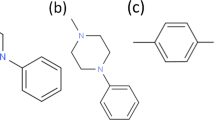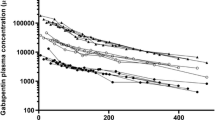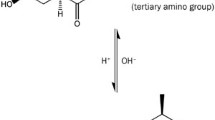Abstract
Purpose. The purpose of this study was to determine if the intestinal transport of pregabalin (isobutyl -γ-aminobutyric acid, isobutyl GAB A), a new anticonvulsant drug, was mediated by amino acid carriers with affinity for large neutral amino acids (LNAA).
Methods. Pregabalin transport was studied in rat intestine and Caco-2 monolayers. An in vitro Ussing/diffusion chamber model and an in situ single-pass perfusion model were used to study rat intestinal transport. An in vitro diffusion chamber model was used to evaluate Caco-2 transport.
Results. In rat ileum, pregabalin transport was saturable and inhibited by substrates of intestinal LNAA carriers including neurontin (gabapentin), phenylalanine, and proline. Weak substrates of intestinal LNAA carriers (β-alanine, -γ-aminobutyric acid, and methyl aminoisobutyric acid) did not significantly change pregabalin transport. In Caco-2 mono-layers that showed a high capacity for phenylalanine transport, pregabalin transport was concentration- and direction-independent and equivalent in magnitude to the paracellular marker, mannitol. The in vitro and in situ rat ileal permeabilities of the LNAA carrier-mediated compounds neurontin, pregabalin, and phenylalanine correlated well with the corresponding in vivo human oral absorption.
Conclusions. The transport of pregabalin was mediated by LNAA carriers in rat ileum but not in Caco-2 monolayers. Caco-2 was not an appropriate model for evaluating the in vivo human oral absorption of pregabalin and neurontin.
Similar content being viewed by others
REFERENCES
T.-Z. Su, E. Lunney, G. Campbell, and D. L. Oxender. Transport of gabapentin, a γ-amino acid drug, by system L α-amino acid transporters: A comparative study in astrocytes, synaptosomes, and CHO cells. J. Neurochem. 64:2125–2131 (1995).
B. H. Stewart, A. R. Kugler, P. R. Thompson, and H. N. Bockbrader. A saturable transport mechanism in the intestinal absorption of gabapentin is the underlying cause of the lack of proportionality between increasing dose and drug levels in plasma. Pharm. Res. 10:276–281 (1993).
R. J. Thurlow, D. R. Hill, and G. N. Woodruff. Comparison of the uptake of [3H]-gabapentin with the uptake of L-[3H]-leucine into rat brain synaptosomes. Br. J. Pharmacol. 118:449–456 (1996).
C. P. Taylor, M. G. Vartanian, P.-W. Yuen, C. Bigge, N. Suman-Chauhan, and D. R. Hill. Potent and stereospecific anticonvulsant activity of 3-isobutyl GABA relates to in vitro binding at a novel site labeled by tritiated gabapentin. Epilepsy Research. 14: 11–15 (1993).
U. Fagerholm, M. Johansson, and H. Lennernäs. Comparison between permeability coefficients in rat and human jejunum. Pharm. Res. 13:1336–1342 (1996).
S. Chong, S. A. Dando, K. M. Soucek, and R. A. Morrison. In vitro permeability through Caco-2 cells is not quantitatively predictive of in vivo absorption for peptide-like drugs absorbed via the dipeptide transporter system. Pharm. Res. 13:120–123 (1996).
E. Walter, S. Janich, B. J. Roessler, J. M. Hilfinger, and G. L. Amidon. HT29-MTX/Caco-2 cocultures as an in vitro model for the intestinal epithelium: In vitro-in vivo correlation with permeability data from rats and humans. J. Pharm. Sci. 85:1070–1076 (1996).
G. L. Amidon, P. J. Sinko, and D. Fleisher. Estimating human oral fraction dose absorbed: A correlation using rat intestinal membrane permeability for passive and carrier mediated compounds. Pharm. Res. 5:651–654 (1988).
B. H. Stewart, O. H. Chan, R. H. Lu, E. L. Reyner, H. L. Schmid, H. W. Hamilton, B. A. Steinbaugh, and M. D. Taylor. Comparison of intestinal permeabilities determined in multiple in vitro and in situ models: Relationship to absorption in humans. Pharm. Res. 12:693–699 (1995).
S. Yee. In vitro permeability across Caco-2 cells (colonic) can predict in vivo (small intestinal) absorption in man—fact or myth. Pharm. Res. 14:763–766 (1997).
H. Lennernäs, S. Nylander, and A.-L. Ungell. Jejunal permeability: A comparison between the Ussing chamber technique and the single-pass perfusion in humans. Pharm. Res. 14:667–671 (1997).
G. M. Grass and S. A. Sweetana. In vitro measurement of gastrointestinal tissue permeability using a new diffusion cell. Pharm. Res. 5:372–376 (1988).
H.-H. Lu, J. Thomas, and D. Fleisher. Influence of D-glucose-induced water absorption on rat jejunal uptake of two passively absorbed drugs. J. Pharm. Sci. 81:21–25 (1992).
K.-O. Vollmer, A. von Hodenberg, and E. U. Kölle. Pharmacokinetics and metabolism of gabapentin in rat, dog and man. Drug Res. 36:830–839 (1986).
P. W. Swaan, G. J. Marks, F. M. Ryan, and P. L. Smith. Determination of transport rates for arginine and acetaminophen in rabbit intestinal tissues in vitro. Pharm. Res. 11:283–287 (1994).
D. C. Dawson. Na and Cl transport across the isolated turtle colon: Parallel pathways for transmural ion movement. J. Membr. Biol. 37:213–233 (1977).
W.-C. Yen and V. H. L. Lee. Penetration enhancement effect of Pz-peptide, a paracellularly transported peptide, in rabbit intestinal segments and Caco-2 cell monolayers. J. Contr. Rel. 36:25–37 (1995).
L. K. Munck and B. G. Munck. Chloride-dependent intestinal transport of imino and γ-amino acids in the guinea pig and rat. Am. J. Physiol. 266:R997–R1007 (1994).
B. G. Munck, L. K. Munck, S. N. Rasmussen, and A. Polache. Specificity of the imino acid carrier in rat small intestine. Am. J. Physiol. 266:R1154–R1161 (1994).
H. N. Christensen. On the strategy of kinetic discrimination of amino acid transport systems. J. Membr. Biol. 84:97–103 (1985).
R. K. Buddington and J. M. Diamond. Ontogenetic development of monosaccharide and amino acid transporters in rabbit intestine. Am. J. Physiol. 259:G544–G555 (1990).
B. G. Munck and L. K. Munck. Phenylalanine transport in rabbit small intestine. J. Physiol. 480:99–107 (1994).
U. Fagerholm, A. Lindahl, and H. Lennernäs. Regional intestinal permeability in rats of compounds with different physicochemical properties and transport mechanisms. J. Pharm. Pharmacol. 49:687–690 (1997).
M. Hu and R. T. Borchardt. Transport of a large neutral amino acid in a human epithelial cell line (Caco-2): uptake and efflux of phenylalanine. Biochim. Biophys. Acta. 1135:233–244 (1990).
H. N. Christensen. Role of amino acid transport and counter-transport in nutrition and metabolism. Physiol. Rev. 70:43–77 (1990).
G. D. Bartoszyk, N. Meyerson, W. Reimann, G. Satzinger, and A. von Hodenberg. Gabapentin. In B. S. Meldrum and R. J. Porter (eds.), New Anticonvulsant Drugs, John Libby and Company, Ltd., London, 1986, pp. 147–164.
S. Budavari. The Merck Index, Merck Research Laboratories, Whitehouse Station, NJ, 1996.
D. R. Lide. CRC Handbook of Chemistry and Physics, Chemical Rubber Company, Boca Raton, 1994.
A. Leo and C. Hansch. Partition coefficients and their uses. Chem. Rev. 71(6):525–616 (1971).
D. Hollander, D. Ricketts, and C. A. R. Boyd. Importance of 'probe' molecular geometry in determining intestinal permeability. Can. J. Gastroenterol. 2(Suppl. A):35A–38A (1988).
Author information
Authors and Affiliations
Corresponding author
Rights and permissions
About this article
Cite this article
Jezyk, N., Li, C., Stewart, B.H. et al. Transport of Pregabalin in Rat Intestine and Caco-2 Monolayers. Pharm Res 16, 519–526 (1999). https://doi.org/10.1023/A:1018866928335
Issue Date:
DOI: https://doi.org/10.1023/A:1018866928335




